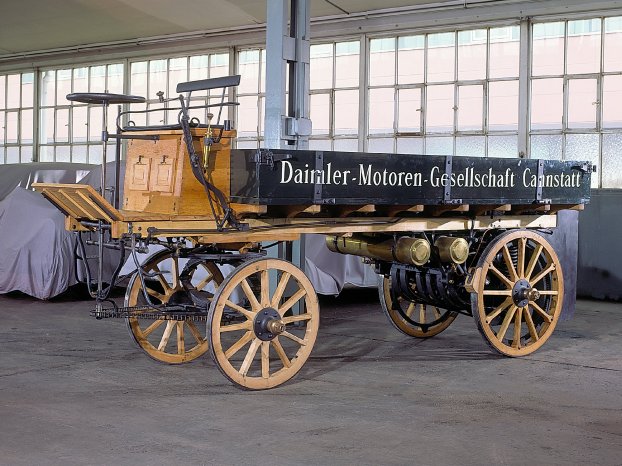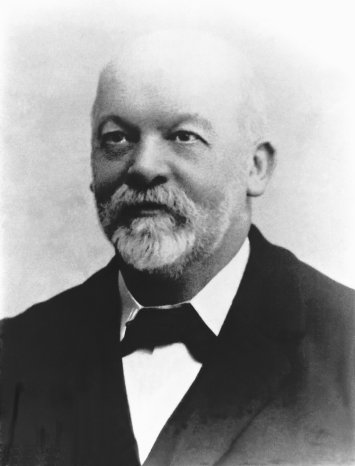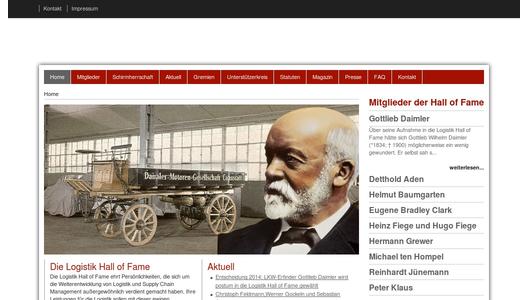Outlining the reasons for the decision, Anita Würmser, Executive Jury Chairperson of the Logistics Hall of Fame said: "In Gottlieb Daimler, a man prevailed who not only had the vision of a motorised society but also possessed the technical genius to make this vision a reality. His induction was only a matter of time". Gottlieb Daimler will be inducted into the pantheon of logistics on November 27 during a ceremony at a gala event in the Erich Klausener Hall of the Federal Transport Ministry in Berlin.
The world's first truck: Daimler's late work
Gottlieb Wilhelm Daimler was 62 years old and at the zenith of his career when he landed this major coup. October 1, 1896 marked the day when the Daimler-Motoren-Gesellschaft company delivered the word's first truck, paving the way for Germany's rich tradition as an exporter of trucks. The vehicle was sold to the British Motor Syndicate in London for 4,600 goldmarks, equivalent to around 45,00 euros in today's money. The customers in England were satisfied with their purchase. They received a quality product in keeping with Daimler's credo: "The best - or nothing". The first model was powered by a 4 hp two-cylinder engine and was designed to carry an impressive payload of 1,500 kg.
The first motorised workhorse designed for the road looked more like a horse-drawn carriage. The engine was situated below the rear axle, and the truck had a top speed of just 16 kmh - but only if was not carrying a full load. Yet the flexibility and performance capability of this new vehicle type ensured that its successors became established as the number one means of overland transport. Today, over 2.6 million trucks of all weight classes are registered in Germany alone, and trucks account for more than 70 percent of traffic volume in the field of freight transport in Germany. The truck is therefore the undisputed backbone of the transport system and therefore of our modern economy characterised by the division of labour.
Gottlieb Daimler never expected a boom of this kind. He is reported to have said: "The worldwide demand for motor vehicles will not exceed one million - if for no other reason than there are not enough chauffeurs". And this prediction also included automobiles. According to other sources, he forecast that worldwide demand would be as low as 5,000 vehicles.
Life and achievements of Gottlieb Daimler
Gottlieb Daimler was born in Schorndorf in southern Germany on March 17, 1834. He completed grammar school at the age of 14 and underwent training as a gunsmith. After his first job in a mechanical engineering firm, he studied Engineering and was awarded a degree by the Polytechnical College in Stuttgart. During the period from mid-1860 to the end of 1862, Daimler worked in several industrial firms in Paris, Oldham, Leeds, Manchester and Coventry. He then occupied various positions, including a nine-year spell as Technical Director on the management of Gasmotorenfabrik Deutz AG in Cologne. Daimler left Deutz in 1882 at the age of 48 and started his own company. Three years later, in 1885, he moved on from engines to vehicles and registered a patent for a motor bicycle with wooden frame- the so-called "riding car". In the spring of 1886, just a few months after Carl Benz's launched his patented three-wheeled "Motorwagen", the Daimler motor coach was built and became the world's first four-wheeled automobile. Together with partners, Daimler founded a stock corporation under the name Daimler-Motoren-Gesellschaft (DMG) on November 28, 1890. After withdrawing from the company due to conflicts with his co-owners, Daimler became a shareholder again in 1894/95 and was subsequently appointed Chairman of the Supervisory Board. The engineering genius, successful entrepreneur and pioneer of road freight transport died at the age of 65. He only lived to see the nascent phase of the all-conquering truck.
The Logistics Hall of Fame: milestones and the people behind them
The Logistics Hall of Fame honours leading figures who have made outstanding efforts to promote the further development of logistics and supply chain management. The initiative is supported by the Federal Ministry of Transport as well as the relevant sector associations, media and companies, including the Agiplan consulting company, CG Beteiligungsgesellschaften, the Port of Duisburg (duisport), DPD, the Euro-FH University of Applied Sciences, logistics insurer Kravag, the Fahrzeugwerk Bernard Krone company, intralogistics provider Still, the Federal Central Cooperative for Road Transport (SVG) and the TimoCom freight exchange. The aim of the Logistics Hall of Fame is to act as a worldwide platform to publicise the performance capability of logistics and its importance for society.
To date, 18 logisticians have been inducted into the sector pantheon. Alongside Gottlieb Daimler, the other major figures posthumously voted into the Hall of Fame include William Tunner, the man who organised the Berlin Airlift, Gottfried Schenker as a pioneer of combined transportation, Eugene Clark, the inventor of the forklift truck, Malcom McLean, father of containerisation, and Japanese Toyota manager Taiichi Ohno, who invented the just-in-time concept. Other members of the Logistics Hall of Fame include entrepreneur and logistics benefactor Klaus-Michael Kühne as well as the contract logistics pioneers Heinz Fiege and Hugo Fiege, long-time President of the German Association of Road Haulage, Logistics and Disposal (BGL) Hermann Grewer, Dortmund-based logistics researcher Michael ten Hompel, the long-time CEO of BLG, Detthold Aden, BVL founder Hanspeter Stabenau and other innovative professors.
The Hall of Fame can be accessed free of charge at any time at www.logistikhalloffame.de and features information and photos on logistics milestones and the people behind them.
Daimler's first truck
Daimler's first truck had 4 hp, a payload of 1,500 kg and was sold to a company in England for the princely sum of 45,000 euros in today's money. It didn't remain a one-of-a-kind for long. In the spirit of optimism that marked the approach of the new century, industry also pinned its hopes on the motorisation of means of transport. In 1897, DMG marketed a series of delivery vans for payloads from 500 to 2,000 kg under the name "Daimler - Business Vehicle". The series comprised five models with 3 hp, 4 hp, 6 hp, 8 hp and 10 hp.
At the Automobile Exhibition in Paris in 1898, Gottlieb Daimler and Wilhelm Maybach presented a new truck model for payloads of 5 tons. The four-cylinder in-line engine was mounted at the front under a bonnet, and powered by a change speed mechanism, cardan shaft and pinion acting on the real wheels. Optically, this truck was a recognisable predecessor of the modern generation of trucks, whereas the models that had previously been sold looked more like redesigns of horse-drawn coaches. Source: Daimler AG



